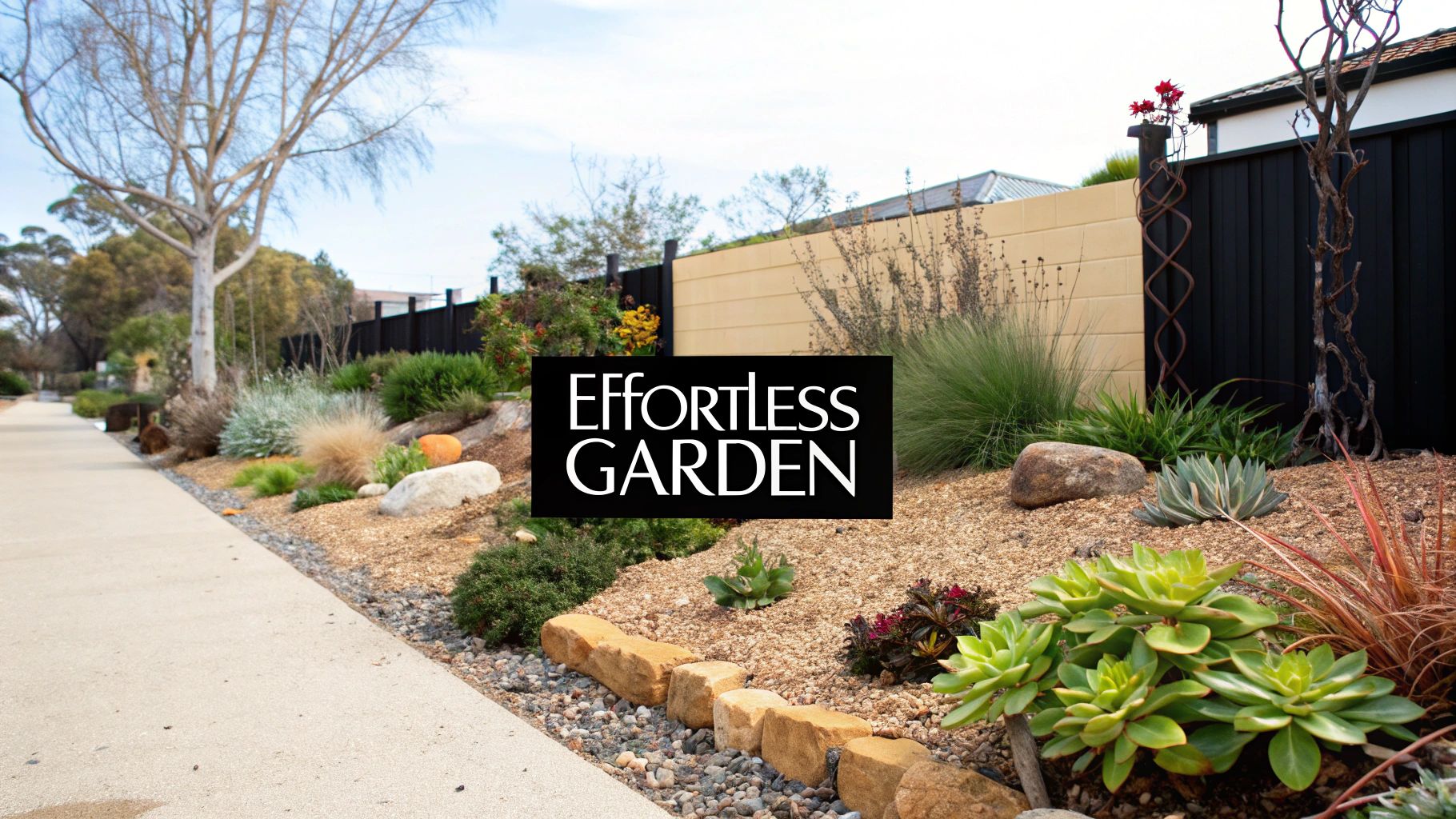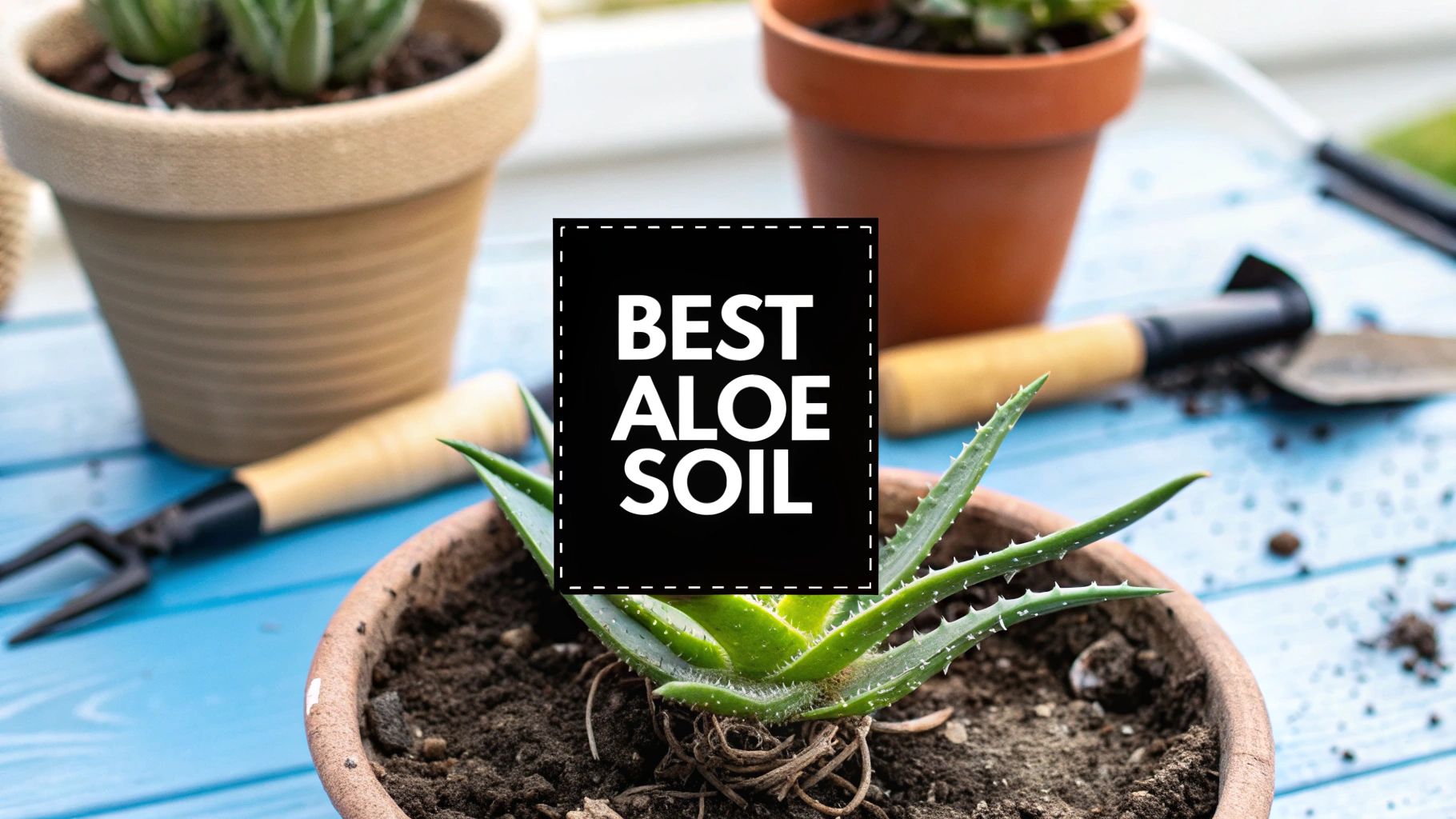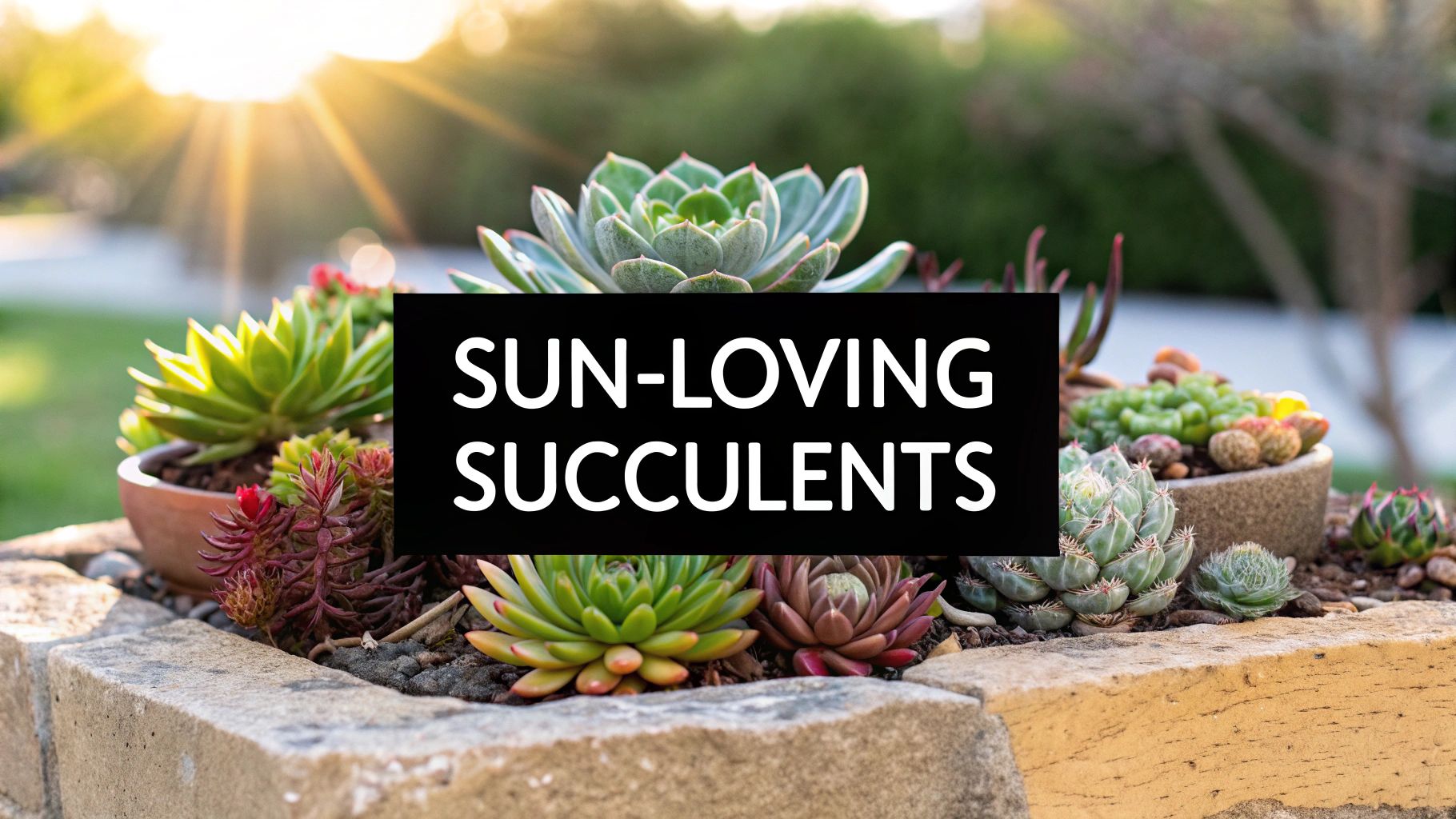Imagine a vibrant, stunning landscape that thrives with minimal effort. This means less watering, less pruning, and more time for you to simply enjoy your outdoor space. Achieving this isn't a gardener's fantasy; it's a reality made possible by choosing the right low maintenance landscaping plants. This guide is dedicated to a curated list of ten champions of easy-care gardening, selections that deliver maximum beauty for minimum work.
We'll move beyond the obvious choices to provide specific, actionable insights into how each plant can transform your garden. A crucial step in creating an effortless garden is choosing plants that naturally thrive in your existing environment, for example, selecting plants suited for challenging soil conditions like clay can dramatically reduce upkeep. Whether you're battling drought, difficult soil, or just a busy schedule, these hardy selections provide year-round interest and structural beauty without demanding constant attention.
This list features resilient, striking plants like Lavender, Sedum, Russian Sage, and hardy Yuccas. Prepare to discover how to build a garden that works for you, making your landscape a source of joy, not a list of chores. We will explore how to best utilize each plant for stunning, sustainable results.
1. Lavender (Lavandula)
Lavender is a fragrant, drought-tolerant perennial herb prized for its iconic purple flowers and silvery-green foliage. Native to the Mediterranean, this hardy plant is a cornerstone of low-maintenance landscaping, thriving in conditions that many other plants find challenging. Its ability to flourish in poor, sandy, or rocky soils with minimal water once established makes it an incredibly resilient choice for busy gardeners or those in arid climates.

Beyond its beauty and resilience, lavender is a functional addition to any garden. It attracts beneficial pollinators like bees and butterflies while its natural oils act as a deterrent for many common garden pests. Beyond its appealing scent and beauty, planting lavender can also contribute to natural pest management. Discover more about how lavender can naturally repel ants and other unwanted insects.
Implementation and Care
- Sun and Soil: Plant in a location that receives at least six hours of direct sunlight daily. Lavender demands well-draining soil to prevent root rot; amend heavy clay soils with sand or gravel.
- Watering: Water newly planted lavender regularly for the first year. Once established, it is extremely drought-tolerant. Water deeply but infrequently, allowing the soil to dry out completely between waterings.
- Pruning: Prune back the plant by about one-third after it finishes flowering in late summer. This encourages bushier growth and prevents it from becoming woody and sparse.
Lavender works beautifully in Mediterranean-style gardens, xeriscaped yards, and as a border plant along pathways where its fragrance can be enjoyed.
2. Sedum (Stonecrop)
Sedum, commonly known as stonecrop, encompasses over 400 species of succulent plants celebrated for their incredible drought tolerance and minimal care requirements. These fleshy-leaved plants are true survivors, storing water in their leaves and stems, which allows them to thrive in poor soils and challenging conditions. Offering a wide range of forms from low-growing ground covers to taller, upright perennials, sedum is one of the most versatile low maintenance landscaping plants available.

This plant's resilience has made it a favorite among rock garden enthusiasts and pioneers of the green roof movement. Its ability to form a dense mat of foliage helps suppress weeds, control erosion, and create a "living mulch" effect around larger plants and trees. From the coastal gardens of the Pacific Northwest to xeriscaped yards in Arizona, stonecrop provides year-round texture and color with almost no effort.
Implementation and Care
- Sun and Soil: Sedum thrives in full sun and requires well-draining soil. To prevent root rot, amend heavy or clay soils with sand or gravel to improve drainage.
- Watering: Once established, stonecrop is exceptionally drought-tolerant. Water new plants occasionally until they are established, then only water during prolonged, extreme drought.
- Maintenance: Avoid fertilizing, as overly rich soil can cause weak, leggy growth. Divide clumps every 3 to 4 years in the spring to rejuvenate the plants and maintain their vigor.
Sedum is perfect for rock gardens, filling gaps in stone walls, edging sunny borders, and creating expansive, water-wise ground covers.
3. Russian Sage (Perovskia atriplicifolia)
Russian Sage is a woody perennial subshrub prized for its airy texture, silvery-gray aromatic foliage, and tall spikes of lavender-blue flowers that bloom from mid-summer through fall. Native to Central Asia, this incredibly tough plant is a champion of low maintenance landscaping plants, thriving in heat, drought, and poor soils. Its ability to provide long-lasting color with virtually no care once established makes it a favorite among gardeners and designers, particularly those in dry climates.

Beyond its resilience, Russian Sage offers a unique structural element to the garden, with a fine, misty appearance that softens bolder plants and creates a sense of movement. It is a key plant in the "New Perennial" movement, popularized by designers like Piet Oudolf, for its naturalistic look and season-long interest. This plant attracts pollinators like bees and butterflies while being resistant to deer and rabbits, adding both beauty and function to the landscape. Its prominent use in places like the High Line in New York City showcases its suitability for modern, sustainable garden designs.
Implementation and Care
- Sun and Soil: Plant in a location that receives full sun, at least six hours daily. Excellent drainage is non-negotiable; Russian Sage abhors wet feet and will rot in heavy, waterlogged soil. It performs best in average to poor soil and does not require rich amendments.
- Watering: Water regularly during its first growing season to establish a deep root system. Once established, it becomes extremely drought-tolerant and requires very little supplemental water.
- Pruning: Cut the woody stems back to about 6-12 inches from the ground in late winter or early spring, just as new growth begins to emerge. This encourages vigorous new growth and a better floral display.
4. Ornamental Grasses (Various Species)
Ornamental grasses are a diverse group of low maintenance landscaping plants, including fountain grass, feather reed grass, and miscanthus, that provide year-round structure and movement. Prized for their seasonal interest, they offer a dynamic display of changing colors, textures, and graceful seed heads that persist through winter. Many varieties are extremely drought-tolerant once established, making them a superb choice for gardeners seeking both beauty and resilience with minimal effort.

Popularized by designers like Piet Oudolf and the New American Garden movement, these grasses add a soft, naturalistic feel to landscapes. They excel at creating visual interest in prairie-inspired designs, as seen in Chicago's Lurie Garden, and work equally well in modern, minimalist settings. Their ability to thrive in various conditions makes them an excellent component of a sustainable garden. Discover more about how they fit into a water-wise landscape by exploring other drought-tolerant landscape plants that pair well with them.
Implementation and Care
- Sun and Soil: Most ornamental grasses prefer full sun, which encourages robust growth and vibrant color. They are adaptable to a wide range of soil types but perform best in well-draining soil.
- Watering: Water regularly during the first growing season to establish a deep root system. Once mature, most species require very little supplemental watering, except during prolonged periods of extreme heat and drought.
- Maintenance: Cut back the foliage to about 4-6 inches from the ground in late winter or early spring before new shoots emerge. This single annual task is typically all the maintenance required. For easier management, choose clump-forming varieties over aggressive spreaders.
5. Yucca (Yucca species)
Yucca plants are architectural succulents native to the hot, arid regions of the Americas, characterized by their bold, sword-like leaves arranged in rosettes. Many varieties produce dramatic, tall spikes of white, bell-shaped flowers in the summer, adding a stunning vertical element to the landscape. As one of the most resilient low maintenance landscaping plants, yucca requires virtually no attention once established, making it a perfect choice for xeriscaping, desert gardens, and modern designs.
The strong, sculptural form of the yucca provides a dramatic focal point year-round, offering a distinct visual contrast to softer, mounding plants. Its extreme drought tolerance and ability to thrive in poor soil make it an exceptionally sustainable and water-wise option. These impressive succulents are a key feature in many arid landscapes, from the Desert Botanical Garden in Phoenix to modern residential yards in Southern California. Discover more about the diverse yuccas of the Southwest and their unique characteristics.
Implementation and Care
- Sun and Soil: Plant in a location that receives full sun. Yucca is not picky about soil but absolutely requires excellent drainage to prevent root rot; sandy or rocky soil is ideal.
- Watering: Water new plants occasionally until they are established. Mature yuccas are incredibly drought-tolerant and rarely need supplemental watering, except in the most extreme heat.
- Pruning: Yuccas are very low-maintenance. Simply remove the spent flower stalk after blooming has finished. Dead or damaged lower leaves can be trimmed off at the base to keep the plant tidy.
Yucca is best used as a specimen plant or a structural accent in rock gardens, coastal landscapes, and container plantings where its powerful form can be appreciated.
6. Catmint (Nepeta species)
Catmint is a tough, long-blooming perennial prized for its aromatic, gray-green foliage and profuse spikes of blue or purple flowers. A member of the mint family, this hardy plant offers months of color from late spring through fall, making it a reliable choice for low-maintenance landscaping plants. Its exceptional drought tolerance once established, combined with its resistance to deer and other common garden pests, solidifies its place as a garden workhorse.
Beyond its resilience, catmint is a magnet for beneficial pollinators like bees and butterflies, bringing life and movement to the garden. Unlike its more aggressive relatives, many ornamental cultivars are well-behaved and won't spread uncontrollably. It's an excellent choice for creating soft, billowy texture in borders, along pathways, or in rock gardens, pairing beautifully with roses and other sun-loving perennials to create a classic cottage garden feel.
Implementation and Care
- Sun and Soil: Plant in a location with full sun to light shade. Catmint thrives in average, well-draining soil and is not fussy about soil fertility; it tolerates poor or rocky conditions well.
- Watering: Water regularly during its first growing season to establish a deep root system. Once mature, it is extremely drought-tolerant and requires minimal supplemental watering.
- Pruning: After the first major flush of flowers fades in midsummer, shear the entire plant back by about one-third. This encourages a fresh flush of foliage and a second round of blooms that lasts into the fall.
Catmint's versatility makes it ideal for everything from English cottage designs and xeriscaped gardens to modern, low-water landscapes.
7. Agave (Agave species)
Agaves are dramatic, rosette-forming succulents native to the Americas, celebrated for their thick, fleshy leaves that often feature sharp marginal spines. These striking architectural plants are some of the most low maintenance landscaping plants available, providing bold, sculptural elements to the landscape. They are extremely drought-tolerant and can thrive for decades with minimal intervention, making them ideal for modern, desert, or xeriscaped gardens where water conservation is key.
Beyond their stunning form, Agaves are incredibly resilient, flourishing in full sun and poor, rocky soils where other plants struggle. Their strong, geometric shapes create powerful focal points, adding texture and year-round interest. For those looking to dive deeper into these fascinating succulents, you can explore the wonderful world of Agaves and discover the vast diversity within the species.
Implementation and Care
- Sun and Soil: Plant in a location that receives full sun. Agaves require excellent drainage to prevent root rot, so sandy or gravelly soil is ideal. Amend heavy soils to improve drainage before planting.
- Watering: Water newly planted agaves occasionally until established. Once mature, they are exceptionally drought-tolerant and require very little supplemental water, often thriving on natural rainfall alone in many climates.
- Placement: Consider the plant's mature size when choosing a location, as some species can grow very large. Plant them away from high-traffic areas and walkways due to their sharp spines. For colder climates, smaller varieties can be grown in containers and moved indoors during winter.
Agaves are perfect for creating a dramatic statement in rock gardens, container plantings, and as standalone specimens in arid landscapes.
8. Barberry (Berberis species)
Barberry is a versatile and durable shrub, valued for its dense, thorny branches and striking foliage that comes in shades of deep red, vibrant gold, and rich green. This hardy plant is a top choice for low-maintenance landscaping plants because it adapts to a wide range of soil types and environmental conditions. Once established, it is remarkably drought-tolerant and resistant to many common pests and diseases, making it a truly resilient option for any garden.
Beyond its ornamental appeal, barberry serves a practical purpose as a natural security barrier. Its sharp thorns deter intruders and unwanted wildlife, making it ideal for creating secure hedges around property lines or under windows. The plant offers year-round visual interest, with small yellow flowers in spring, colorful foliage through summer, and bright red berries that persist into winter, providing food for birds. It is crucial to select non-invasive cultivars to prevent their spread into natural areas.
Implementation and Care
- Sun and Soil: Barberry thrives in full sun to partial shade. Full sun exposure brings out the most vibrant foliage colors. It is not particular about soil type but requires good drainage to prevent root issues.
- Watering: Water new plants regularly during their first growing season to establish a strong root system. Mature plants are highly drought-tolerant and need only occasional watering during prolonged dry spells.
- Pruning: Prune in late winter or early spring before new growth appears to shape the plant or remove any dead or crossing branches. Always wear heavy gloves and protective clothing due to the sharp thorns.
Barberry is exceptionally useful for creating foundation plantings, defining borders, or stabilizing slopes. Its tough nature makes it a reliable choice for commercial landscapes and residential security hedges alike.
9. Coneflower (Echinacea species)
Coneflowers are robust North American native perennials celebrated for their distinctive, daisy-like flowers that feature prominent, spiky central cones. As a cornerstone of low-maintenance landscaping plants, these hardy flowers thrive in a variety of conditions with minimal care. Their deep taproots make them incredibly drought-tolerant once established, and they provide a spectacular display of color from mid-summer through fall, often when other plants have faded.
Beyond their striking appearance, Coneflowers are a powerhouse for supporting local ecosystems. They are a magnet for essential pollinators like bees and butterflies, and their seed heads are a valuable food source for birds such as goldfinches throughout the fall and winter. This dual function of providing beauty and ecological benefits makes Echinacea an ideal choice for naturalistic plantings, prairie-style gardens, and any landscape designed to be both beautiful and beneficial.
Implementation and Care
- Sun and Soil: Plant in a location that receives full sun, meaning at least six hours of direct sunlight per day. Coneflowers require well-draining soil and are adaptable to various soil types, but they will not tolerate consistently wet conditions.
- Watering: Water regularly during their first growing season to help establish a strong root system. Once mature, they are very drought-tolerant and will only need supplemental watering during extended dry spells.
- Maintenance: Deadhead spent blooms to encourage a longer flowering period. However, be sure to leave some of the last seed heads standing through winter to provide food for birds. Clumps can be divided every three to four years in the spring if they become overcrowded.
Coneflowers are perfect for mass plantings, mixed perennial borders, and cottage gardens, adding reliable, long-lasting color and texture with very little effort.
10. Juniper (Juniperus species)
Junipers are versatile evergreen conifers prized for their exceptional durability and year-round interest. Ranging from low, spreading ground covers to tall, stately trees, these plants are a cornerstone of low-maintenance landscaping due to their adaptability to a wide range of climates and soil conditions, including poor, rocky, or sandy ground. Their resilience in the face of drought, heat, and cold makes them a go-to choice for difficult planting sites where other plants might fail.
Beyond their hardiness, junipers offer significant functional benefits. Their dense growth habits make them excellent for weed suppression, slope stabilization, and providing shelter for birds. With textures from fine and feathery to coarse and sharp, and colors from deep green to silver-blue and gold, junipers provide essential structure and color that persists through the winter. This makes them one of the most reliable low maintenance landscaping plants for four-season appeal.
Implementation and Care
- Sun and Soil: Junipers thrive in full sun, requiring at least six hours of direct sunlight daily to maintain dense growth. They demand well-draining soil and are highly intolerant of "wet feet," so avoid planting them in boggy or low-lying areas.
- Watering: Water new plants regularly during their first growing season to establish a strong root system. Once established, they are extremely drought-tolerant and typically only need supplemental water during prolonged, severe droughts.
- Pruning: Junipers require very little pruning. If needed, light trimming can be done in late winter or early spring to shape the plant or remove dead branches. Avoid cutting back into old wood, as it will not regrow.
Juniper is ideal for foundation plantings, rock gardens, xeriscaping, and as a durable ground cover for large areas like slopes or commercial medians.
Low Maintenance Plants Comparison Chart
| Plant | Implementation Complexity 🔄 | Resource Requirements ⚡ | Expected Outcomes 📊 | Ideal Use Cases 💡 | Key Advantages ⭐ |
|---|---|---|---|---|---|
| Lavender | Moderate – needs pruning and good drainage | Low – drought tolerant, minimal water | Long blooming period, pest deterrent, attracts pollinators | Mediterranean-style gardens, xeriscaping, culinary/aromatherapy | Fragrant flowers, low water needs, deer resistant |
| Sedum | Low – easy to grow, may need division to control | Very low – thrives in poor soils | Dense mats for erosion control, year-round interest | Rock gardens, green roofs, xeriscaped landscapes | Extreme drought tolerance, diverse species, low maintenance |
| Russian Sage | Moderate – requires spacing and occasional cutting | Low – minimal water once established | Long bloom, attracts pollinators, good contrast in borders | Xeriscaping, perennial borders, naturalistic plantings | Deer resistant, aromatic foliage, extended bloom |
| Ornamental Grasses | Moderate – annual cutback, some invasive potential | Low to Moderate – varies by species | Seasonal texture and movement, wildlife habitat | Mass plantings, erosion control, prairie and rain gardens | Year-round interest, low maintenance, drought tolerant |
| Yucca | Moderate – slow growth, requires space | Very low – minimal water after establishment | Bold architectural focal points, spectacular flowers | Desert gardens, modern landscapes, specimen plant | Dramatic form, drought tolerant, deer resistant |
| Catmint | Low – may spread, occasional shearing required | Low – drought tolerant | Continuous bloom, attracts pollinators | Edging, pollinator gardens, xeriscaping | Long bloom, deer resistant, low maintenance |
| Agave | Moderate – slow growth, careful placement needed | Very low – drought tolerant | Dramatic sculptural interest, long-lived | Desert and modern gardens, container planting | Architectural form, drought tolerant, deer resistant |
| Barberry | Moderate – pruning difficult due to thorns | Low to Moderate – drought tolerant | Year-round colorful foliage, security barriers | Security hedges, commercial landscapes, foundation plantings | Hardy, drought tolerant, deer resistant, provides barriers |
| Coneflower | Low – minimal care, occasional division | Low to Moderate – drought tolerant | Long bloom, supports wildlife, winter interest | Prairie gardens, pollinator gardens, naturalistic plantings | Native, long blooming, drought and deer resistant |
| Juniper | Moderate – minimal pruning, select correct variety | Very low – drought tolerant | Year-round color and structure, erosion control | Foundation plantings, slopes, rock gardens | Evergreen, hardy, drought tolerant, long-lived |
Start Building Your Low-Effort Landscape Today
Creating a stunning, vibrant landscape doesn't have to be a sentence to endless weekend chores. As we've explored, the secret lies in strategic selection, choosing resilient plants that are naturally suited to thrive with minimal intervention. By embracing the robust beauty of these low maintenance landscaping plants, you can design a garden that works with nature, not against it, freeing up your time and conserving precious resources like water and energy.
The journey from a high-effort yard to a low-maintenance oasis is built on a few core principles. It begins with understanding your unique environment: the hours of sunlight, the quality of your soil, and your regional climate. Armed with this knowledge, you can confidently select plants from this list that are pre-adapted to your specific conditions, setting them up for success from day one.
Key Takeaways for a Thriving, Low-Effort Garden
Remember that a successful low-maintenance garden is a well-planned one. It's not just about what you plant, but how you combine them to create a cohesive, self-sustaining ecosystem.
- Embrace Diversity: A mix of textures, heights, and forms creates visual interest year-round. Combine the airy plumes of Ornamental Grasses with the bold, architectural shapes of Yucca or Agave. Use the fine texture of Russian Sage or Catmint to soften the strong lines of hardy shrubs like Barberry and Juniper.
- Layer for Impact: Think in layers, from ground-hugging Sedum that suppresses weeds to mid-height perennials like Coneflower and Lavender, and finally to taller structural plants that provide a strong backbone to your design. This creates a full, dynamic look that requires less infill planting later on.
- Group by Need: Perhaps the most crucial takeaway is to group plants with similar water and sun requirements together. This is the cornerstone of efficient, low-effort gardening. Placing drought-tolerant superstars like Agave and Lavender next to water-loving plants creates a maintenance nightmare. A well-zoned garden is an easy-care garden.
Mastering these concepts allows you to build a landscape that is not only beautiful but also resilient and environmentally responsible. You'll spend less time watering, weeding, and fertilizing, and more time simply enjoying the sensory experience of your outdoor space, from the scent of Lavender on a warm afternoon to the gentle rustle of ornamental grasses in the breeze. Your garden becomes a sanctuary for both you and local pollinators, a testament to the idea that less truly can be more.
Ready to find the perfect architectural centerpiece for your new garden? For premium, drought-tolerant specimens like the Agave and Yucca featured in this guide, explore the curated collection at The Cactus Outlet. Their expertly grown plants provide the instant structure and bold form needed to anchor any low-maintenance design. Visit The Cactus Outlet to discover a resilient, statement-making plant that will thrive for years to come.




